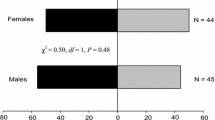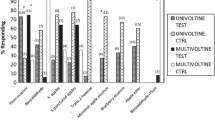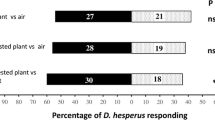Abstract
A two-choice, wind-tunnel olfactometer was designed and contructed to determine whether second-instar eastern spruce budworm larvae,Christoneura fumiferana (Clem.), could detect and discriminate among host-plant volatiles. Volatiles of current year's growth ofPicea glauca were preferred over those ofP. rubens, P. mariana, or air.Abies balsamea was preferred overP. mariana or air.P. rubens andP. mariana were both preferred over air. Two-year-old growth ofP. glauca, A. balsamea, P. rubens, andP. mariana were all preferred over air. Current year's growth of these host evergreen species was usually preferred over former year's growth of the same species in each case.
Similar content being viewed by others
References
Albert, P. J. 1982. Host plant preferences in larvae of the eastern spruce budworm,Choristoneura fumiferana. Proc. 5th Int. Symp. Insect-Plant Relationships, Wageningen, pp. 19–24.
Albert, P. J., andJerrett, P. A. 1981. Feeding preferences of spruce budworm (Choristoneura fumiferana Clem.) larvae to some host-plant chemicals.J. Chem. Ecol. 7:391–402.
Albert, P. J., Seabrook, W. D., andPaim, U. 1970. The antennae as the site of pheromone receptors in the eastern spruce budwormChoristoneura fumiferana (Lepidoptera: Torticidae).Can. Entomol. 102:1610–1612.
Albert, P. J., Cearley, C., Hanson, F., andParisella, S. 1982. Feeding responses of eastern spruce budworm larvae to sucrose and other carbohydrates.J. Chem. Ecol. 8:233–239.
Anderson, J. M., andFisher, K. C. 1960. The response of the white pine weevil to naturally occurring repellents.Can. J. Zool. 38:547–564.
Brewer, G. J. 1983. Attractiveness of glandular and simple-hairedMedicago clones with different degrees of resistance to the alfalfa seed chalcid (Hymenoptera: Eurytomidae) tested in an olfactometer.Environ. Entomol. 5(12):1504–1508.
Dethier, V. G. 1980. Responses of some olfactory receptors of the eastern tent caterpillar (Malacosoma americanum) to leaves.J. Chem. Ecol. 6:213–220.
Dethier, V. G., andSchoonhoven, L. M. 1969. Olfactory coding by lepidopterous larvae.Entomol. Exp. Appl. 12:535–543.
Ferreira, L., Pintureau, B., andVoegele, J. 1979. Un nouveau type d'olfactomètre. Application à la mesure de la capacité de recherche et à la localisation des subtances attractives de l'hôte chez les Trichogrammes (Hym.: Trichogrammatidae).Ann. Zool. Ecol. Anim. 11:271–279.
Fraenkel, andGunn, D. L. 1961. Pages 58–75in The Orientation of Animals. Kineses, Taxes and Compass Reactions. Dover Publications, New York.
Guerra, A. A. 1968. New techniques to bioassay the sex attractant of pink boilworms with olfactometers.J. Econ. Entomol. 61:1253–1254.
Kamm, J. A., andButtery, R. G. 1983. Response of the alfalfa seed chalcidBruchophagus roddi, to alfalfa volatiles.Entomol. Exp. Appl. 33:129–134.
Katsoyannos, B. I., Boller, E. F., andRemund, U. 1980. A simple olfactometer for the investigation of sex pheromones and other olfactory attractants in fruit flies and moths.Z. Angew. Entomol. 90:105–112.
Khatter, P., andSaxena, K. N. 1978. Interaction of visual and olfactory stimuli determining orientation ofPapilio demoleus larvae.J. Insect Physiol. 24:571–576.
Lecomte, C., andThibout, E. 1981. Attraction d'Acrolepiopsis assectella, en olfactomètre, par des substances allélochimiques volatiles d'Allium porrum.Entomol. Exp. Appl. 30:293–300.
McMorran, A. 1965. A synthetic diet for the spruce budwormChoristoneura Jumiferana (Clem.) (Lepidoptera: Tortricidae).Can. Entomol. 97:58–62.
Mustaparta, H. 1975. Behavioral responses of the pine weevilHylobius abietis L. (Col.: Curculionidae) to odors activating different groups of receptor cells.J. Comp. Physiol. 102:57–68.
Nettles, W. C., Jr. 1980. AdultEucelatoria sp. response to volatiles from cottonGossypium hirsutum and okraAbelmoschus escolentus plants from larvae ofHeliothis virescens, Spodoptera eridania andEstigmene acra.Environ. Entomol. 9:759–763.
Rust, M. K., andReierson, D. A. 1977. Using pheromone extract to reduce repellency of Blatticides.J. Econ. Entomol. 70:34–38.
Shaw, G. G. andLittle, C. H. A. 1973. Dispersal of second instar spruce budworm.Bi-Mon. Res. Notes, Can. For. Serv. 29:30–31.
Sokal, R. R., andRohlf, F. J. 1969. Introduction to Biostatistics. W. H. Freeman, San Francisco, 776 pp.
Sutherland, O. R. W. 1972. The attraction of newly hatched codling moth (Lasperyresia pomonella) larvae to apple.Entomol. Exp. Appl. 15:481–487.
Swaine, J. M., andCraighead, F. C. 1924. Studies on the spruce budworm. Can. Dept. Agr. Tech. Bull. 37.
Thorsteinson, A. J. 1960. Host selection in phytophagous insects.Ann. Rev. Entomol. 5:193–218.
Vet, L. E. M., Van Lenteren, J. C., Heymans, M., andMeelis, E. 1983. An airflow olfactometer for measuring olfactory responses of hymenopterous parasitoids and other small insects.Phys. Entomol. 8:97–106.
Von Rudloff, R. 1972. Seasonal variation in the composition of the volatile oil of the leaves, buds, and twigs of white spruce (Picea glauca).Can. J. Bot. 50:1595–1603.
Von Rudloff, E. 1975. Seasonal variation in the terpenes of the foliage of black spruce.Phytochemistry 14:1695–1699.
Wood, D. L., andBushing, R. W. 1963. The olfactory response ofIps confusus (Le Conte) (Coleoptera: Scolytidae) to the secondary attraction in the laboratory.Can. Entomol. 95:1066–1078.
Author information
Authors and Affiliations
Rights and permissions
About this article
Cite this article
Ascoli, A., Albert, P.J. Orientation behavior of second-instar larvae of eastern spruce budwormChoristoneura fumiferana (Clem.) (Lepidoptera: Tortricidae) in a y-type olfactometer. J Chem Ecol 11, 837–845 (1985). https://doi.org/10.1007/BF01012072
Received:
Accepted:
Issue Date:
DOI: https://doi.org/10.1007/BF01012072




